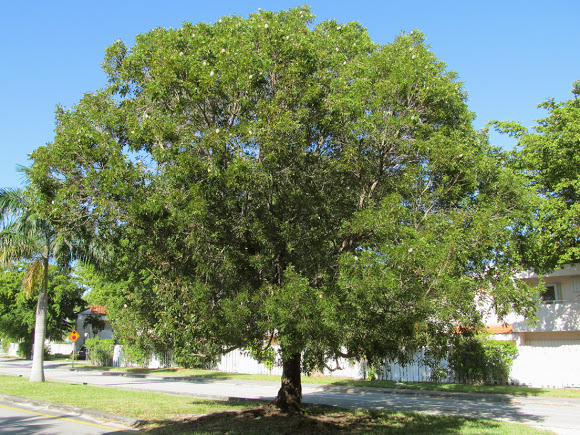Description and biology
The American mahogany, also called the West Indian or Cuban mahogany, is a fast–growing semi–evergreen tree. It grows to a height of about 40 to 60 feet (12.2 to 18.2 meters) and spreads out to a width of about the same measure. Its bark is smooth and gray in its early years and becomes darker and browner as the tree ages. An older tree has flaky, ridged bark.
The 4– to 8–inch (10.2– to 20.5–centimeter) leaves come in clusters, with 4 to 8 leaflets of about one–quarter inch (.65 centimeter) length. The oval leaves are dark green on top and reddish–brown underneath. They have sharp tips and a smooth surface.
The American mahogany has small 3– to 6–inch green or white flowers that are barely noticeable to a casual observer. The flowers are unisexual (either male or female, but not both, as some flowers are). They are pollinated by insects.
  |
In the fall or the winter, one flower will develop into a fruit, a large, woody, 2– to 5–inch (5– to 12–centimeter) pod. When the pods are mature (in 8 to 10 months), they release flat, brown seeds. This cycle usually takes place on an annual basis in trees that are 10 to 15 years old.
Habitat and current distribution
The American mahogany occurs in subtropical dry or wet forests at altitudes ranging from sea level to about 2,625 feet (800 meters). The species does best in rich, moist soil, but it is currently found most frequently in dry, stony areas. American mahogany trees are usually found scattered, with only one or two trees on a one–acre section of the forest.
The American mahogany is native to Cuba, Haiti, Jamaica, the Dominican Republic, the Bahamas, and the Florida Keys. The species, though, has been cultivated by humans for many years; in some cases it is difficult for scientists to determine which populations are native to an area. The species has been introduced to Puerto Rico, the Virgin Islands, the Lesser Antilles, Trinidad, Tobago, and elsewhere in the Caribbean Islands.
History and conservation measures
American mahogany has long been prized for its durable, deep red, straight–grained wood, which has been used to make fine furniture for centuries. It was first used during the reign of King George I of England (1714 to 1727).
Europe imported its mahogany from Jamaica, Cuba, and Honduras. By 1774, American mahogany had become scarce because of its popularity in furniture–making. By the late 1800s, the species was nearly eliminated from Cuba, and was in decline elsewhere.
Few stands of American mahogany now exist in the wild because of the over exploitation of the species for the furniture industry and because of the development of the lands that the tree favors.
The species is much more likely to be found planted in someone’s yard or along a city street than in its natural habitat. Where it does grow wild, the species has undergone dramatic changes.
Trees are likely to be much smaller and more like bushes, with many branches. Since 1992, the trade of American mahogany has been restricted under the Convention on International Trade in Endangered Species of Wild Fauna and Flora (CITES).

